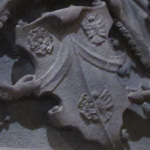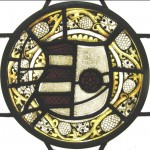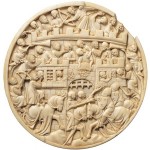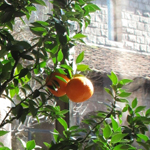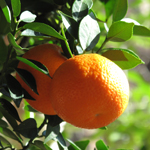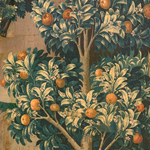Archive for the ‘Plants in Medieval Art’ Category
Friday, February 10, 2012
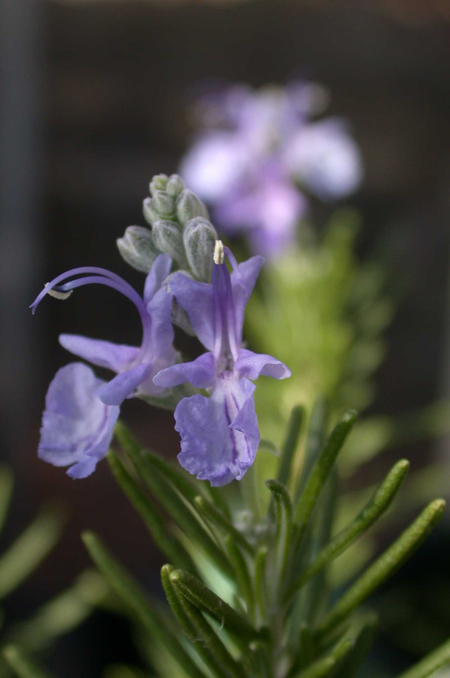
In the later Middle Ages, the leaves, stems, and flowers of this aromatic??member of the mint family??were used to effect cures for many ills, and provide protection from both spiritual and bodily harm. Photograph by Nathan Heavers
Libanotis which the Romans call Rosmarinus & they which plait crowns use it: the shoots are slender, about which are leaves, small, thick, and somewhat long, thin, on the inside white, but on the outside green, of a strong scent. It hath a warming facultie . . .
???Dioscorides, De Materia Medica, Book III: 89
It is an holy tree and with folk that hath been rightful and just gladly it groweth and thriveth. In growing it passeth not commonly in height the height of our Lord Jesu Christ while he walked as a man on earth, that is man’s height and half, as man is now; nor, after it is 33 years old, it growth not in height but waxeth in breadth and that but little. It never seareth all but if some of the aforesaid four weathers make it.
???Friar Henry Daniel, “little book of the virtues of rosemary,” ca. 1440
Read more »
Tags: Dioscorides, Hortulus, rosemary, Rosmarinus officinalis, Salerno, St. Gall, Walahfrid Strabo, Westminster, Wilton Diptych
Posted in Medicinal Plants, Plants in Medieval Art, The Medieval Garden | Comments (1)
Friday, February 3, 2012
The trees went to anoint a king over them: and they said to the olive tree: Reign thou over us
And it answered: Can I leave my fatness, which both gods and men make use of, to come to be promoted among the trees?
???Judges 9: 8-9, Douay-Rheims Bible
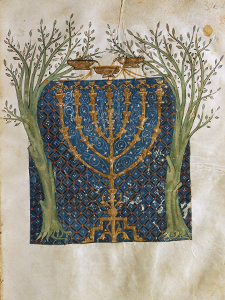

Olive oil provided fuel for sanctuary lamps throughout the Mediterranean world in antiquity and the Middle Ages, as well as holy oils for religious purposes. Above, left: A menorah flanked by two olive trees, as depicted in the Cervera Bible, recently on view at the Main Building. The brimming vessels?? used to fill the lamp appear at the top of the menorah. Right: A fifth-century standing lamp decorated with a cross; bronze lamps of this type were common in the early Byzantine world.
The olive was held to be the first of trees in both classical and biblical antiquity, prized above even the grapevine and the fig. A gift of the goddess Athena, the sacred olive symbolized the arts of peace and prosperity; the ruthless destruction of an enemy’s olive groves in wartime was held to be sacrilegious act. The Roman natural historian Pliny, writing in the first century A.D., attests that Athena’s olive was still venerated on the Athenian acropolis in his day (Historia naturalis, XVI 239???40). Although slow to bear, the tree is very long lived, surviving for hundreds of years. (The SpiceLines blog features an illustrated post about a Spanish olive estimated to be eighteen hundred years old.)
Read more »
Tags: chrism, drupe, glucoside, Hildegard of Bingen, Mediterranean, oil, oleaster, olive, Physica, Pliny, Tacuinum Sanitatis
Posted in Food and Beverage Plants, Medicinal Plants, Plants in Medieval Art, Useful Plants | Comments (0)
Friday, January 27, 2012
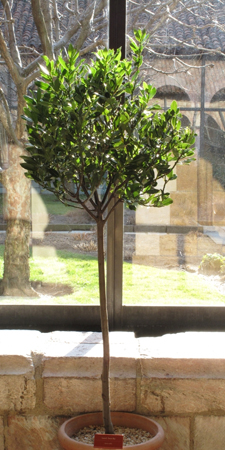
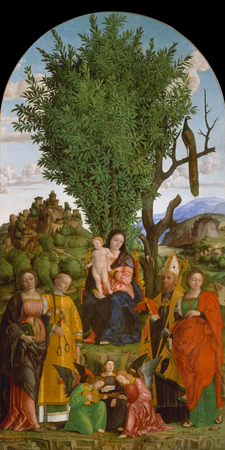
The evergreen bay laurel (Laurus nobilis), a symbol of victory and eternal life, is not as tender as some other Mediterranean species, but it must be grown in pots and wintered over indoors at The Cloisters. Above, left: Bay laurel topiaries like this one spend the winter in the glassed-in arcades of Cuxa cloister and return to Bonnefont herb garden in May. Right: The magnificent bay tree that flourishes at the center of Girolamo dai Libri’s Madonna and Child with Saints represents Resurrection, and is juxtaposed with the naked limbs of a dead tree.
The laurel itself is a bringer of peace, inasmuch as to hold a branch of it out even between enemy armies is a token of cessation of hostilities. With the Romans especially it is used as a harbinger of rejoicing and of victory, accompanying despatches and decorating the spears and javelins of the soldiery and adorning the generals??? rods of office. From this tree a branch is deposited in the lap of Jupiter the All-good and All-great whenever a fresh victory has brought rejoicing, and this is not because the laurel is continually green, nor yet because it is an emblem of peace, as the olive is to be preferred in both respects, but because it flourishes in the greatest beauty on Mount Parnassus, and consequently is thought to be also dear to Apollo, to whose shrine even the kings of Rome at that early date were in the custom of sending gifts and asking for oracles in return.
???Pliny, Historia Naturalis, Book XV, 133
Read more »
Tags: Apollo, bay, cinnamon, Daphne, Dioscorides, evergreen, Girolamo dai Libri, Hildegard of Bingen, Jashemski, laurel, Laurus nobilis, Ovid, Pliny, Pompeii
Posted in Gardening at The Cloisters, Medicinal Plants, Plants in Medieval Art, Useful Plants | Comments (1)
Thursday, December 8, 2011
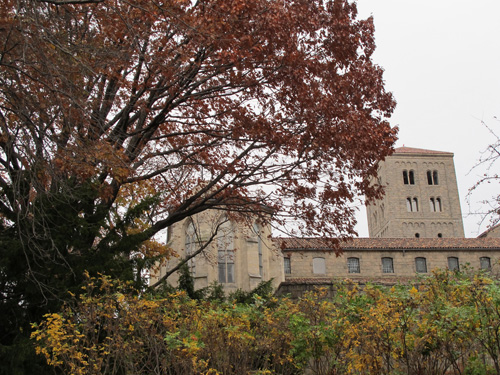
An Eastern black oak (Quercus velutina) outside The Cloisters.?? Photograph by Theo Margelony
Its wood is strong and hard and durable. Its beams supported high roofs over castles and churches. Its boards closed off doorways and gateways, denying passage to all but the most obstinate or determined, and were used to create interior floors from small chambers to large halls. Panels of it were shaped and carved into chests and choir stalls. Its planks were worked into ships and bridges, wagons and carts. Read more »
Tags: acorn, fructed, heraldry, oak, Quercus
Posted in Plants in Medieval Art | Comments (7)
Friday, October 28, 2011
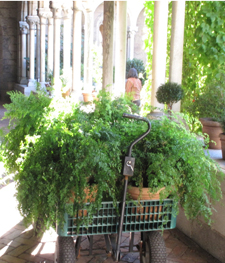
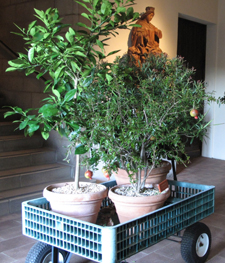
Potted plants too tender to spend the winter in Bonnefont garden are trucked inside and brought up to Cuxa cloister, which is??glazed in mid-October. Mediterranean plants such as bitter orange, myrtle, and bay laurel spend the cold season in the sunny arcades and??are brought back out to the herb garden when the glass comes down in mid-April. Left:??A wagonload of maidenhair fern in the arcade of Bonnefont garden. Right:??oranges and pomegranates en route to Cuxa cloister.?? Photographs by Carly Still
While the medieval plant collection at The Cloisters includes a good number of northern European species, a great many of the plants grown in the Bonnefont Cloister herb garden are Mediterranean in origin. Not all of these southern European plants are hardy for us here in New York City. The garden is a sheltered U.S.D.A. Hardiness Zone 7, and the fig tree (Ficus carica), poet’s jasmine (Jasminum officinale), and lavender (Lavandula angustifolia) do just fine outdoors, but more tender species like bitter orange (Citrus aurantium), rosemary (Rosmarinus officinalis), bay laurel (Laurus nobilis), and dittany of Crete (Origanum dictamnus) must be brought inside and protected from the cold. Read more »
Tags: Albertus Magnus, bay, Citrus aurantium, cucumber, cucurbit, dittany, fern, ficus carica, fig, jasmine, Jasminum officinale, laurel, Laurus nobilis, Lavandula angustifolia, Lavender, maidenhair, myrtle, orange, Origanum dictamnus, rosemary, Rosmarinus officinalis, santolina, winter
Posted in Food and Beverage Plants, Fragrant Plants, Gardening at The Cloisters, Introduction, Magical Plants, Medicinal Plants, Medieval Agriculture, Plants in Medieval Art | Comments (2)
Wednesday, October 12, 2011
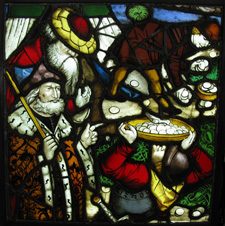
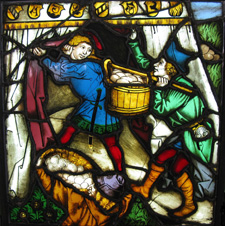
The marvelous food??depicted in these two panels of Late Gothic German stained glass may have been of vegetable origin. Left: Gathering Manna. Moses, holding the staff received from God on Mount Sinai, presides over the gathering of a miraculous fall of quail and manna from heaven. Right: Storing up Manna. Two men bear a large wooden tub of manna into a tent; a third man carries a great basketful in his arms.
The identification of Biblical plants has occupied investigators for centuries; the identity of manna is??one of??the most intriguing and most debated of ethnobotanical mysteries, although some interpreters have suggested that the substance is of insect rather than vegetable origin. Read more »
Tags: Albertus Magnus, algae, Avicenna, Bible, Circa Instans, Coccus manniparus, Exodus, Fraxinus ornus, Hortus Sanitatis, Lecanora esculenta, lichen, manna, Nostoc commune, Platearius, tamarisk, Tamarix mannifera
Posted in Food and Beverage Plants, Medicinal Plants, Plants in Medieval Art | Comments (1)
Friday, September 2, 2011
Plantagenet. Since you are tongue-tied and so loath to speak,
In dumb significants proclaim your thoughts:
Let him that is a true-born gentleman
And stands upon the honour of his birth,
If he suppose that I have pleaded truth,
From off this brier pluck a white rose with me.
Somerset. Let him that is no coward nor no flatterer,
But dare maintain the party of the truth,
Pluck a red rose from off this thorn with me.
???Henry VI, Part 1, Act 2, Scene 4
After the fleur-de-lis, the rose is probably the second most common floral charge to appear on heraldic shields. That’s quite understandable, since the rose’s emblematic associations ranged from the Virgin Mary to the Five Wounds of Christ to romantic love. In the military context of knights and noble families, the rose also suggested the fierce and often impenetrable thicket of prickled branches in which it grows. The white roses strewn around the fearsomely armed lion rampant that occurs on the shield of Finland might have raised just such an association in the minds of beholders. Alternately, roses might also have been chosen as a play on a name???the arms of the German town of Rosenberg in Baden-W??rttemberg, for example, or the Baltic baronial family von Rosen.
Read more »
Tags: fleur-de-lis, heraldry, roses, Shakespeare, Tudor
Posted in Plants in Medieval Art | Comments (1)
Thursday, August 11, 2011
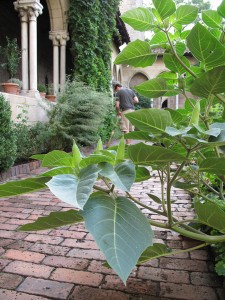
My early morning sweep of Bonnefont garden, overseen by the downy thornapple (Datura metel). Photograph by Corey Eilhardt
A quiet life has many rewards: not least of these
Is the joy that comes to him who devotes himself to the art
They knew at Paestum, and learns the ancient skill of obscene
Priapus???the joy that comes of devoting himself to a garden.
???From Hortulus by Walahfrid Strabo. Translated from the Latin by Raef Payne. The Hunt Botanical Library, 1966.
Read more »
Tags: Benedict, Benedictine, bryan_stevenson, ground ivy, internship, jasmine, monk, nightshade, nun, pear, potato beetle, spearmint, Walahfrid Strabo
Posted in Gardening at The Cloisters, Plants in Medieval Art | Comments (4)
Friday, March 11, 2011
At certain times of the year in the medieval rural landscape, it would have been common to see plump sheaves of grain standing in sunny fields like so many golden tokens of agricultural wealth and prosperity, as numerous depictions???even in some of the most sumptuous manuscripts of the Middle Ages, such as the Belles Heures of the duke of Berry???attest. At harvest, the wheat was cut at the base of the stalk with a sickle and then gathered up in large armfuls and tied about the middle. The resulting bundles were left spaced and standing upright in the fields, which allowed them to dry even if it happened to rain before they could carted off for threshing.
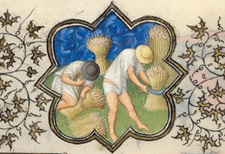
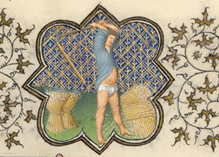
Details of illuminations from Folio 8r and Folio 9r from the Belles Heures of Jean de France, duc de Berry, 1405???1408/9.
Read more »
Tags: barley, Belles Heures, blazon, Bolton, caraway, carrot, Cheshire, Comyn, cumin, Cuminum cyminum, garb, Geoffrey Chaucer, gold, grain, Grosvenor, heraldic, heraldry, John of Gaunt, oat, Owain Glynd??r, parsley, rye, Scrope, sheaf, sheaves, shield, wheat
Posted in Plants in Medieval Art | Comments (1)
Friday, February 18, 2011
Above: Both bitter and sweet oranges were introduced into Europe from Asia, but the bitter species preceded the sweet species by??five centuries. The bitter Citrus aurantium var. myrtifolia, a sport, or spontaneous mutation, of the medieval species suitable for pot culture, overwinters on the sunny side of the Cuxa Cloister arcade. The fruit of Citrus aurantium is economically important as a flavoring, although it is too bitter to eat out of hand. The sweet orange, Citrus sinensis, depicted in The Unicorn is Found, would have been introduced only about fifty years before the tapestry was designed.
The bitter orange, Citrus aurantium, spread from its native China to India in ancient times. The orange is mentioned in an early Ayurvedic medical text, Charaka Samhita. According to food historian Alan Davidson, the Sanskrit “naranga” became naranj in Arabic, narantsion in post-classical Greek, and aurantium in Late Latin. Albertus Magnus, the first medieval writer to describe the bitter orange, called the fruit “arangus,” from which the Italian arancia and the French and English “orange” all derive. Read more »
Tags: Ayurvedic, Charaka Samhita, Citrus aurantium, Citrus sinensis, limonaia, myrtifolia, orange, orangerie, stomachic, Tacuinum Sanitatis
Posted in Gardening at The Cloisters, Plants in Medieval Art | Comments (2)











